10 June, 2023
A meander through the countryside
There is a spot on Three Bridges Road, St. Jacobs where someone routinely fills a bird feeder with seed and replenishes cakes of suet when they have been eaten.
This young Raccoon (Procyon lotor) was making short work of this one.
A Great Blue Heron (Ardea herodias) had other food on its mind.
One usually associates herons with fish, amphibians, and other aquatic species but they are very adept at stalking through a grassland and capturing rodents, sometimes as large as Groundhogs (Marmota monax), and snakes. A lightening strike from a heron, delivered with pinpoint accuracy, permits few prey to escape their fate.
A Song Sparrow (Melospiza melodia) probably has little to fear, but all the same, better to be wary.
We are fortunate that Cedar Waxwing (Bombycilla cedrorum) is resident in southern Ontario so that we may enjoy it throughout the year.
Near Milverton, ON
There is a thrift store in Milverton that we check if we are close by; Miriam has found some great fabric buys there and I have been equally fortunate with books.
An additional bonus this time around was a field with young Eastern Meadowlarks (Sturnella magna) and young Killdeer (Charadrius vociferus).
The birds were moving around quite a bit and were in and out of long grass but we are pretty sure there were two attentive adults and four young of each species.
Here is a couple of the recently fledged meadowlarks.
Baby Killdeer are fuzzy, super-cute, little replicas of their parents, born precocial and ready to leave the nest and forage for themselves within hours of hatching.
The adults remain close by, however and are a virtual paradigm of the distraction display for which many ground-nesting birds are renowned.
Lakeside Park, Kitchener, ON
Lakeside Park is yet another pleasant oasis in a sea of urbanization and a visit there is always enjoyable.
Bluets (genus Enallagma) are especially difficult to identify as to species, especially the males for whom detailed examination of the claspers is required. Since we do not catch, but only observe odenates, specific identification is frequently well nigh impossible.
A male Red-winged Blackbird (Agelaius phoeniceus) presents no such difficulty.
Philadelphia Fleabane (Erigeron philadelphicus) prospers widely, even in disturbed areas with relatively poor soil.
This young Northern Flicker (Colaptes auratus) provides evidence of a successful breeding season - at least for one family.
Common Grackle (Quiscalus quiscula) is quite aggressive at bird feeders and for that reason is disliked by some, but I find it an interesting and attractive bird.
A flotilla of Canada Geese (Branta canadensis) is the watery equivalent of cattle grazing peacefully in a field.
It's hard to know at this stage whether it's a male or a female, but if a male, this is what he will look like when he grows up.
As soon as we see our first Common Whitetail (Plathemis lydia) - and they are very easy to identify - they seem to be everywhere.
One sees the cycle of predation quite clearly with this species as they hawk for mosquitoes and other insects over the water, all the while being eagerly sought by predators higher up the food chain. I think we may heave a sigh of relief as humans that we are generally not considered food by other animals, all the while plundering every species on Earth for our own satisfaction.
As mentioned above, Bluets usually resist identification, and I am unsure of this species.
In similar vein the following species poses a challenge, but I am leaning towards Skimming Bluet (Enallagma germinatum), with some level of confidence, though not a hundred percent.
The Great Blue Heron we had seen earlier decided that a different part of the lake was more favourable and made a spectacular landing.
A short while ago I was bemoaning our loss of caterpillars, but I found myself cheering for this Baltimore Oriole (Icterus galbula) father who had captured a good supply of food for his hungry brood.
Miriam loves Eastern Cottontails (Sylvilagus floridanus); Miriam delights in Eastern Cottontails - as long as they are not in her garden merrily chewing her flowers to the ground.
A juvenile Common Starling (Sturnus vulgaris) was one more example of nature renewing itself.
Another meander through the countryside
Three Bridges Road in St. Jacobs has a bridge spanning the Conestogo River and it is a reliable spot to look for Great Blue Heron.
You will no doubt remember that we are at the epicentre of Mennonite culture in southern Ontario, and at a meeting house on Three Bridges Road, Eastern Bluebirds (Sialia sialis) have successfully raised young for many years. This spring, however, we had not seen one, so were delighted to view a male, albeit on the farthest-most point of the fence surrounding the graveyard.
It remains still to locate a female, and evidence that a pair bond was formed and nesting occurred. Wish us luck!
It follows that because there are so many Old Order Mennonites (and Amish) who follow their traditional ways there are many horses too. They are domesticated, of course, yet remain the focus of our affection.
For the second day in a row the temperature has exceeded thirty degrees and I am saddened when I see these poor beasts trotting along pulling a conveyance of one description or another.
In Ontario (and in all likelihood in other jurisdictions) it is possible to rent swans for the season and a farm we pass regularly does just that. Obviously accustomed to people, and associating them with food, they swim towards us expectantly as soon as we stop the car.
I have cracked corn in the garage, and if only I thought ahead of time I could have taken some with me.
Red-winged Blackbirds are hard to miss.
On Bricker School Line, near Wallenstein, a Red-tailed Hawk (Buteo jamaicensis) surveyed his territory from atop a utility pole.
A little farther along several Savannah Sparrows (Passerculus sandwichensis) were very obliging in terms of posing for pictures.
An Eastern Meadowlark sang to us joyfully, his clear notes bouncing along on the warm air, yet he remained far away.
At the bridge on Broadway Street in Hawkesville, a substantial colony of American Cliff Swallows (Petrochelidon pyrrhonota) was destroyed a few years ago when serious flooding of the Conestogo River occurred. It was good to see that the birds are reclaiming their former nesting site.
Blue Flag-Iris (Iris virginica) is found in wet areas, marshes and alongside rivers and is quite seductive on a languid summer's day.
Mike Schout Wetlands Preserve, New Hamburg, ON
Miriam and I made our first visit to this impressive wetland reserve that recently had its official opening.
The project began in 2019 when Mike Schout approached the Township of Wilmot about utilizing 55 acres of undevelopable floodplain land that was given to the Township to create a preserve that would combine wildlife, the environment, learning, and the health and well-being of the community, that all could enjoy for years to come.
Bravo, Mike. Thank you on behalf of naturalists everywhere.
Many nest boxes have been erected and this was the only one that seems to have been claimed by House Sparrows (Passer domesticus). I doubt that any potential competitor would be anxious to challenge this male standing guard.
Viper's Bugloss (Echium vulgare) is an attractive wildflower that tolerates soil that would not support more delicate species.
A platform has been provided for a pair of Ospreys (Pandion haliaetus) - perhaps next year it will be occupied.
I was impressed by the creative use of branches to serve as perches for the birds. It seems such an elementary addition yet one seldom sees it here, as contrasted with similar structures in Europe where it is standard.
An Osprey was seen fishing over the Nith River; it doubtless already has a home but perhaps one of its young may claim this spot next spring.
Tree Swallows (Tachycineta bicolor), that surpassingly beautiful denizen of its aerial realm, have claimed most of the nest boxes and several contained young with bottomless appetites, keeping their devoted parents busy.
'Tis the time of year for butterflies to be on the wing and a Northern Crescent (Phyciodes cocyta) was a delightful addition to our enjoyment of the day.
Brown-headed Cowbirds (Molothrus ater) have found the wetland exactly to their liking, it appears, no doubt able to exploit the various nests of other birds.
You will note the strategically placed logs to provide habitat for aquatic species and convenient basking platforms for turtles. This wetland has been carefully planned and executed, and all involved have every reason to be pleased with the outcome.
This Grey Tree Frog (Hyla versicolor) is exquisitely patterned and may well have been the highlight of this visit.
Not only have nesting structures been erected for Ospreys there are additional structures to encourage the formation of a heronry, with suitable platforms next to a forested area. Quite brilliant in my opinion.
A young Tree Swallow waited patiently for its parents to swoop by, stuffing insects into its waiting bill.
We observed only one Northern Rough-winged Swallow (Stelgidopteryx serripennis), but there may have been some high fliers that we missed.
At one point eight Killdeers were present together, frequently bathing. This individual was drying off.
It is a sad fact that most ducklings do not make it for more than a few days, being picked off by hawks, snapping turtles, herons, foxes and other predators.
This female had succeeded in raising only one of a brood that probably began as eight or ten.
The intelligent planning that has gone into this location includes an area with suitable substrate for turtles to lay their eggs.
I have not found any confirmation that this condition is part of the moulting sequence, but not having seen it often in a bird that is very common renders that supposition unlikely. Perhaps a parasitic overload is the reason for its denuded state. The bird appeared to be otherwise healthy.
This odd individual marked the end of our circumambulation of the wetland.
Bravo Mike Schout! Bravo Wilmot!


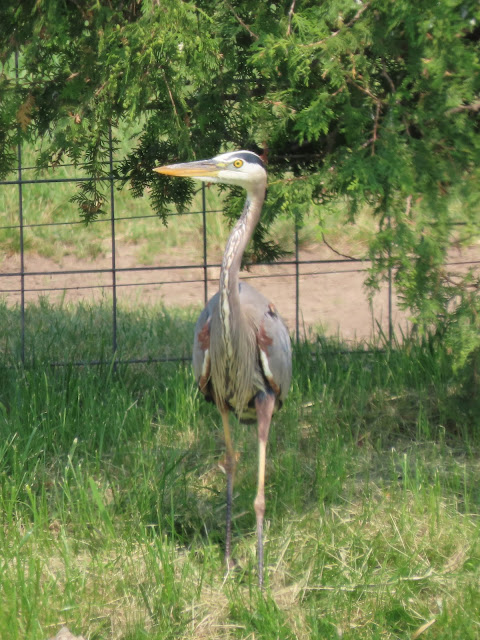

























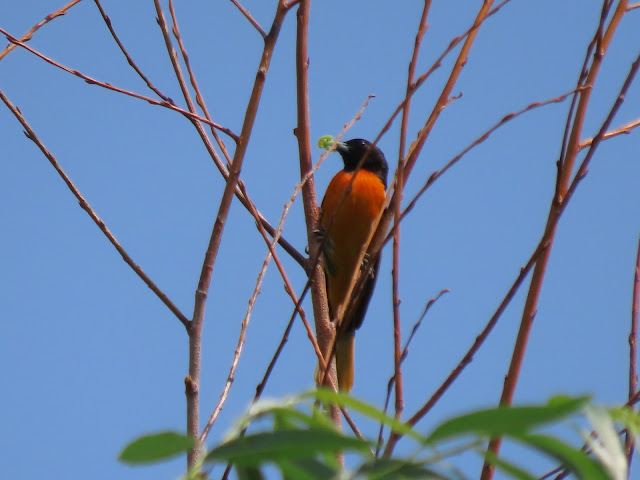




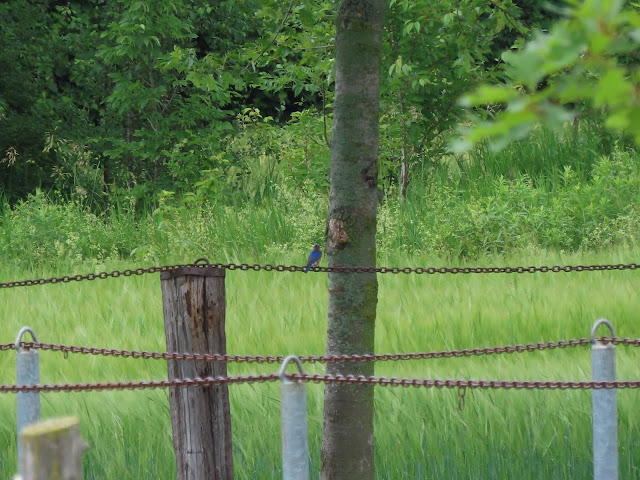





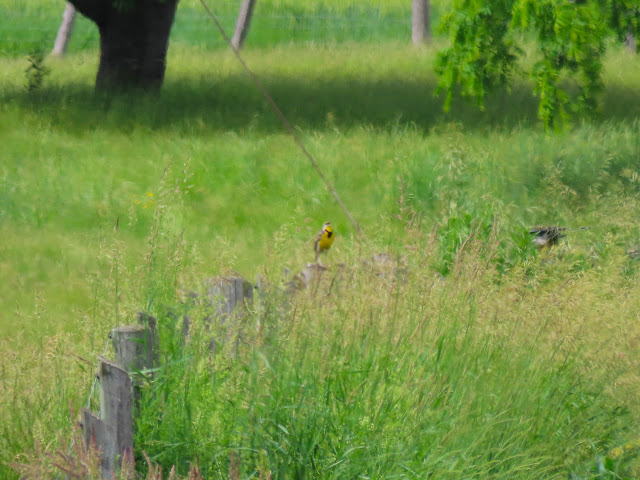















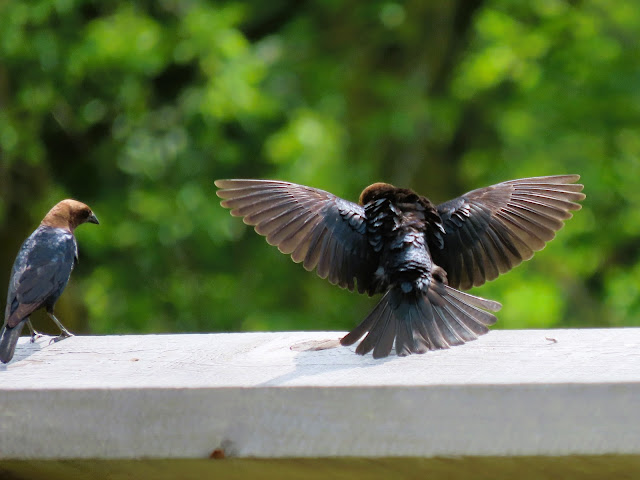




























...David, you made some amazing sightings. I have enjoyed watching the cedar waxwings devourling the fruit in our amelanchier. It's cleaned bare.
ReplyDeleteYou kept yourself very busy.
ReplyDeleteAs long as you continue exploring your neighbourhood, you will be enriching our days.
And it is pure joy.
DeleteUnisual picture of the red-winged Blackbird that lost all feathers from its head. I enjoyed watching your pictures of the marsh bluet.
ReplyDeleteEasy to see you made a great job.
Bravo Mike Schout! Bravo Wilmot! sums it up well. It looks like a fabulous preserve to visit and revisit.
ReplyDeleteThank you and Miriam so much for taking us along.
Thank you for sharing these wonderful sightings, a great mix.
ReplyDelete... but yes, unusual to see that red-winged Blackbird that lost all feathers from its head.
All the best Jan
Lovely shots!
ReplyDeleteAlways such a joy to see your posts. I grew up with several of those birds and they always bring back memories of the lake and the prairieland. :)
ReplyDeleteGlad to rekindle memories for you, Rita.
DeleteThe red winged blackbird doesn't look as handsome as it does with a feathered head. But as long as it's healthy, that is what matters. Yesterday some friends and I went walking at our local Botanical garden and we watched some tree swallows fledging the nest. We could have watched them all day. You certainly had a great month of June viewing wildlife. That raccoon is a smart guy, and such a typical raccoon. Hope July is treating you well. hugs-Erika
ReplyDeleteI liked all the herons you found and especially the nesting platforms.
ReplyDeleteWhat a wonderful place to stroll about/around in, such variety. All is beautiful.
ReplyDeleteThanks for the ride really enjoyed.
Hari Om
ReplyDeleteAlways a delight to read and see what you have been seeing, David. some amazing shots from Miriam and excellent narrative from you. You put us right beside you! YAM xx
What a great series of photos this is David.
ReplyDeleteThe male Red-winged Blackbird and the Baltimore Oriole with caterpillars in the beak are truly amazing.
The mute swan in this position is also super and the young tree swallow is really cute to see.
I enjoyed your photos.
Greetings Irma
You show so many different birds and plants David, and it's a joy to see them all together. The Killdeers look like a true replica of a dinosaur. The Tree Swallow is very cute. Hugs and kisses, Marit
ReplyDeleteIl y'a tant à voir! L'atterrissage du héron est une très belle photo, j'aime aussi beaucoup les couleurs de la grenouille et le joli raton laveur. Bonne journée
ReplyDeleteI think it is wonderful that you have so much beauty and natural wildlife to explore virtually at your back door. Thanks for sharing it with us :)
ReplyDeleteHi David.
ReplyDeleteThis is enjoying all this beautiful nature.
Beautiful the Birds and the Butterflies and Dragonflies.
Nice Raccoon.
Greetings from Patricia.
Your bluet photos are spectacular, and I love the heron landing. I’m trying to imagine a heron eating a groundhog.
ReplyDeleteI have seen a heron in our front yard grab a 3 foot long snake and take it away and also dive on several lizards. the bluets are beautiful, no matter the species. raccoons are crazy and will eat about anything. I like that pathway that is like a jungle, would love to walk it. sorry about your high temps. Last night at 5 pm, went out with the dog and our temp was dead on 100f, 38c our humidity was approaching 100. back in the house we went.
ReplyDeleteawesome photos, as always.. agree with Linda the landing heron is beautiful as is the wing flapping duck, now I am off to ask google why people rent swans
They rent swans for the sheer pleasure of having them around. Many public parks also rent swans for people to enjoy during the spring and summer.
DeleteYou had a great walk and saw many beautiful birds and insects.Love the raccoon. I understand why Miriam doesn't like rabbits in her garden. A heroin strode through the back garden this morning, he was heading for the neighbour's pond! Love the photo of the her on landing, it seems to be dancing. Wonderful shot! Hugs, Valerie 🤗 xxxxx
ReplyDeleteThe raccoon, the rabbit and the horse are a special visual pleasure for me.
ReplyDeleteYou must have had fun taking these pics, getting fresh air and exercise. I envy your ability and talent.
ReplyDeleteEl milagro de la naturaleza, ho lo he podido admirar, en estas fotografías.
ReplyDeleteUn abrazo
What fantastic sightings, so many different ones. Your walks are well documented by the photos. Thanks for sharing, I enjoyed seeing them all.
ReplyDeleteThere isn't any picture that you have shared with us today that didn't bring me joy and bring back many memories. The Blue Heron for instance. I recall a year when all of our yards were overrun with chipmunks. Then one day a Blue Heron arrived ... he came up from the lake and started eating the Chipmunks. He came back every day until there were no more ... I was sad for the Chipmunks, but was in awe of the prowess of this magnificent bird. I am so glad you shared the pictures of the Meadow Lark and the Killdeer parents and fledglings. I once came across a Killdeer in a field who had a nest near by and she went into the broken wing routine to draw me away from her nest. I have pictures that I will share sometime in the near future. I have loved the Killdeers as they used to fly over the University Experiment Station (farm) when my father was there and sing their so recognizable song ... I think I was 4 or 5 years old and I think of those days every time I hear or see one. We also had a small lake just over the border in Wisconsin that had a large field of reeds along one side where the Red Wing Blackbirds would nest. I used to go and sit on an old deserted pier and just watch them. They are beautiful birds, though very aggressive when you are near their nest. The females are more shy and sweet. Oh, and I could tell you stories about Swans. Talk about aggressive. We had a pair at the Rehab facility and the male was so protective of his mate that we had to use a push broom to hold him back so we could put food in their feeder. You never went in their area alone or you would get chased out :0 We had barn swallows on our lake. They would build their nests under the canopies of the boatlifts along the water. They were delightful and they cleared the air of bugs (as did the dragonflies). I have never seen a Northern Rough winged Swallow so that and the Gray Tree Frog were the highlights of your post for me.
ReplyDeleteI feel for the Red Wing Blackbird with the feather loss issue ... I suspect it is a parasite or some form of infection. Hopefully he will recover and grow in a new set of feathers after his molt. I second your Bravo to Mike Schout and Wilmot ... deserving recognition for a job well done. There are occasionally islands of hope for wildlife and environment ... we have had a few in our area as well, but there really is so much more that could be done. And Bravo to you David for sharing are reminding us of the importance of learning and understanding what our role in nature should be.
Andrea @ From the Sol
It makes me so happy, Andrea, that. I am able to rekindle these memories for you. Today we saw a Wood Duck with babies. You would have been delighted.
DeleteI am without computer at the moment, David, so have only been able to enjoy this post on my very ancient tablet, which means that I can't view the images at their best. It is, nevertheless a most interesting post.
ReplyDeleteThe Common Whitetail is a fabulous looking creature!
I look forward eagerly to hearing about your future visits to the Mike Schouts Wetlands Preserve.
Best wishes to you and Miriam - - - Richard
I enjoyed this so much, both photos and your commentary. The wetlands look intriguing, and what a beneficial project. It is interesting to see how many of the same species of birds are are also at home here, hours south of you.
ReplyDeleteHello David,
ReplyDeleteYou have some wonderful spots there for birding. Miriam's bird photos are always amazing. I loved them all but I have a few favorites like the Killdeer and their chicks and the Meadowlarks, I rarely see them around here. The Bluets are lovely images. Thank you for linking up and sharing your post. Take care, have a great weekend. Thank you for leaving me a comment.
Enjoyed seeing all you see on your walks through nature. I grew up near a lake in the desert, and the wetlands were always full of Killdeer. I like listening to their calls. I hear them here when I'm in the garden, but it's not so easy finding them in the state park near us, as it's more for boaters without many trails.
ReplyDeleteBeautiful all the variety of life that is in your area of residence. You notice the warmer days seeing the plants, the light, the shadows and the contrasts, given by a higher sun in the sky. I liked the young kildeería of our Southern lapwing. Kind regards
ReplyDeleteLucky you David, getting to see so many exotic birds...that macro shot of the Marsh Bluet looks really great.
ReplyDeleteWhat stunning photos! I learned some new things while reading this post--thank you. And a thrift store/charity shop that has good fabric and books is not to be missed! I hope you found some great surprises.
ReplyDeleteThere is so much here I don't know where to begin to comment first. But I have to say that heron making a landing is so spectacular it should be entered in a wildlife photo competition or submitted for publication. It is absolutely stunning. I don't know if you or Miriam did that one but hats off. I loved seeing all your creatures. Did you know I am a Bricker, generations ago? My second great grandmother was Lydia Bricker of Berlin (or Kitchner). Her father was John Bricker. So it's fun to hear there is a road in that area with that name. And finally, did Miriam find any nice fabric?
ReplyDeleteInteresting to hear of your local connection to the Brickers of Kitchener, Jeanie. The picture of the heron alighting is Miriam’s. In fact all of the pictures in this episode are hers. Miriam got some fabric, not a lot this time around, but I struck out with books. It’s always worth checking, however, and when we were out there we had lunch at a little Mennonite restaurant called Country Sisters where you get an excellent sandwich with soup or choice of garden, Cesar, potato or macaroni salad for $9.50. It’s a pleasant drive through rich farmland too so we always enjoy it.
DeleteSplendid report for the month of June. Lakeside Park is very beautiful and I loved the blue dragonfly, I've seen some around here, I don't know if it's the same species. The red-winged blackbird is lovely. And I like to see all those wild flowers, quite well known along with the birds that you have found.
ReplyDeleteA big hug and many kisses.
Gracias por tan lindo paseo. Abrazos.
ReplyDeleteWonderful photos! You certainly a great variety of birds and other creatures to observe. I've not been down to the creek for some time, so I'm not sure if the Killdeer returned this year. They, along with the Avocets are my favorites.
ReplyDeleteI did not know the sad fact about ducklings, but I have noticed the broods tend to dwindle as the days passed.
The photos of the Bluets are fabulous! I've yet to get a good photo of a Red-wingedf Blackbird, so kudos to Miriam. The wetlands preserve looks very much like a few I frequent when in Florida.
ReplyDeleteThe wetlands are most beautiful - what a gem to have so close by. This, I am sure, would be a favorite destination of mine.
ReplyDeleteI did know that Great Blue Herons would catch snakes, but I had no idea that they also wouldn't say no to a groundhog.
The heron is my favourite.
ReplyDeleteNature is extraordinary and always enchants our eyes.
ReplyDeleteAll photos are fantastic. I especially loved the photos of Baby Killdeer, how cute, a small copy of his parents.
I also find the wildflower Viper's Bugloss (Echium vulgare) around here.
I've never seen a Gray Tree Frog before.